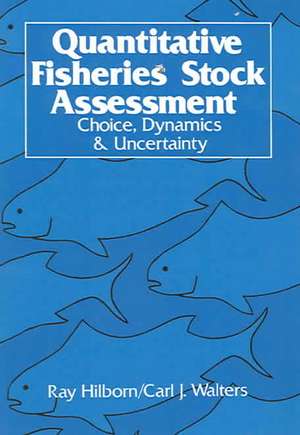Quantitative Fisheries Stock Assessment: Choice, Dynamics and Uncertainty
Editat de R. Hilborn, C.J. Waltersen Limba Engleză Paperback – 30 noi 2003
| Toate formatele și edițiile | Preț | Express |
|---|---|---|
| Paperback (1) | 858.45 lei 38-44 zile | |
| Springer Us – 30 noi 2003 | 858.45 lei 38-44 zile | |
| Hardback (1) | 870.77 lei 38-44 zile | |
| Springer Us – 31 oct 1991 | 870.77 lei 38-44 zile |
Preț: 858.45 lei
Preț vechi: 1129.54 lei
-24% Nou
Puncte Express: 1288
Preț estimativ în valută:
164.32€ • 178.54$ • 138.11£
164.32€ • 178.54$ • 138.11£
Carte tipărită la comandă
Livrare economică 17-23 aprilie
Preluare comenzi: 021 569.72.76
Specificații
ISBN-13: 9781402018459
ISBN-10: 1402018452
Pagini: 592
Ilustrații: XV, 570 p.
Dimensiuni: 155 x 235 x 31 mm
Greutate: 0.82 kg
Ediția:Softcover reprint of the original 1st ed. 1992
Editura: Springer Us
Colecția Springer
Locul publicării:New York, NY, United States
ISBN-10: 1402018452
Pagini: 592
Ilustrații: XV, 570 p.
Dimensiuni: 155 x 235 x 31 mm
Greutate: 0.82 kg
Ediția:Softcover reprint of the original 1st ed. 1992
Editura: Springer Us
Colecția Springer
Locul publicării:New York, NY, United States
Public țintă
ResearchDescriere
This book really began in 1980 with our first microcomputer, an Apple II +. The great value of the Apple II + was that we could take the computer programs we had been building on mainframe and mini-computers, and make them available to the many fisheries biologists who also had Apple II + 's. About 6 months after we got our first Apple, John Glaister came through Vancouver and saw what we were doing and realized that his agency (New South Wales State Fisheries) had the same equipment and could run the same programs. John organized a training course in Australia where we showed about 25 Australian fisheries biologists how to use microcomputers to do many standard fisheries analyses. In the process of organizing this and sub sequent courses we developed a series of lecture notes. Over the last 10 years these notes have evolved into the chapters of this book.
Cuprins
I Introduction.- 1 Role of Stock Assessment in Fisheries Management.- 2 Objectives of Fisheries Management.- II Behavior of Fisheries.- 3 Behavior of Exploited Populations.- 4 The Dynamics of Fishing Fleets.- III Estimation of Parameters.- 5 Observing Fish Populations.- 6 Relating Models to Data: Parameter Estimation.- 7 Stock and Recruitment.- 8 Biomass Dynamic Models.- 9 Delay Difference Models.- 10 Virtual Population Analysis.- 11 Statistical Catch-at-age Methods.- 12 Depletion Estimates of Population Size and Turnover.- 13 Analysis of Body-size and Growth Data.- 14 Multispecies Analysis.- IV Managing Fisheries.- 15 Harvest Strategies and Tactics.- 16 Optimization.- 17 Designing Adaptive Management Policies.- 18 Making Stock Assessment and Management Work.- Author Index.
Recenzii
"..useful in fishery science, population dynamics and fisheries management courses, especially at the undergraduate level...a valuable resource to scientists engaged in fish stock assessment and to fishery managers who wish to advance the state of their art."
(Journal of Natural Resources Modeling)
"...It is an excellent book and should be read by students and practitioners of stock assessment and management of fisheries...I enjoyed the book and commend it."
(ICES Journal of Marine Science)
"Risk and uncertainty have generally received short shrift in the fisheries literature. Hilborn and Waters take a big step toward overcoming this deficiency...I strongly recommend it to serious students and teachers as well as to practicing managers of fisheries for guidance in making more effective marketing decisions."
(Bioscience)
"I will certainly recommend this as one book fisheries scientists must read."
(NAGA, The ICLARM Quarterly)
(Journal of Natural Resources Modeling)
"...It is an excellent book and should be read by students and practitioners of stock assessment and management of fisheries...I enjoyed the book and commend it."
(ICES Journal of Marine Science)
"Risk and uncertainty have generally received short shrift in the fisheries literature. Hilborn and Waters take a big step toward overcoming this deficiency...I strongly recommend it to serious students and teachers as well as to practicing managers of fisheries for guidance in making more effective marketing decisions."
(Bioscience)
"I will certainly recommend this as one book fisheries scientists must read."
(NAGA, The ICLARM Quarterly)
